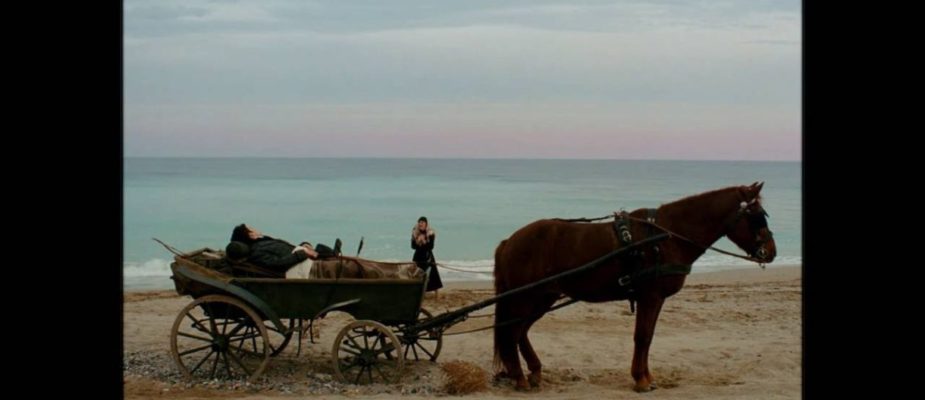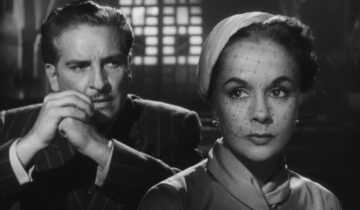A masterful recent work of the Romanian New Wave—a film movement, born in 2005, which shows no signs of creative exhaustion—Radu Jude’s Scarred Hearts (Inimi cicatrizate, 2016) transports us to the Black Sea coast in the summer, fall and winter of 1937, in that moment after Hitler ascended to power in Germany, and before the National Legionary State carried out its own Holocaust in Romania.
Scarred Hearts builds its narrative around the autobiographical writings and personal experiences of Romanian Jewish author Max Blecher (1909-1938). In Jude’s film, Emanuel serves as the writer’s surrogate—he is a Jewish chemistry student and poet who has been admitted into a Black Sea sanitarium for bone tuberculosis. As his condition worsens, Emanuel’s immobile body defines and organizes each blackly comic—or just black—scene, with many filmed in a single, static take. Emanuel’s presence, both physically on screen, in his decaying body, and mentally in a series of philosophically oriented on-screen titles, is the film’s connective tissue, its form of narration. He indeed is the film’s narrator, not least of all for the empathy that his slow experience of death generates in the spectator. Though the mind and ideas are ever present in Scarred Hearts, Emanuel’s body is cardinal to our experience of the film.
Bodies, often reclining on wheeled hospital beds, arranged at various distances from the camera, in immobile takes. This is the first and last impression we are left with in Scarred Hearts; and rightfully so: in this film of mortal illness, Jude reproduces the experiences of his patients with his camera—the motionless, constricted form of their suffering, confined to plaster body casts, is re-articulated in an overwhelmingly static camera that only moves (mostly, if not exclusively) when an orderly is pushing one of the infirmed. If the patients cannot move, neither can the camera. Likewise, it is a camera that eschews cutting within the scene—with the occasion necessity of reorienting bodies aside—allowing instead the (in)action and dialogue to unfold within a single, volumetric space that the director stages horizontally across the rectangular image, and over receding planes.
Rather than following the film from shot to shot, our eye scans, penetrates, and explores alternatively rich and spare visual fields, while off-screen screams and moans underscore those excruciating experiences that the film largely occludes. On narrative grounds, Jude is offering the viewer the spaces of the hospital, seaside, village, and cemeteries in an unbroken duration of time that matches the long hospital days and nights to which Emanuel and his cohort are subjected. The effect is to make Scarred Hearts an especially sculptural experience, again appropriately for a film in which the human subjects are made mostly motionless by their rigid body casts.
At this point, it may be helpful to compare Scarred Hearts to another 2016 world premiere that built its narrative around a single, dying body, Alberto Serra’s very strong The Death of Louis XIV, which screened at the Noble Theater last spring. In The Death of Louis XIV, Serra utilizes widescreen, 2.35:1 cinematography to frame the Sun King in his full royal grandeur, head to toe, across the elongated image. Scarred Hearts, by comparison, adopts a 4:3 Academy-ratio image, cropped, in rounded edges, like early photography. Though we do get a couple of Mantegna’s Lamination of Christ-style foreshortened framings, including one of our emaciated, half-nude Emanuel, Jude often favors more perpendicularly or diagonally framed eye-level compositions, shot in medium and more often long-shot, which once again contribute to the images’ solidity, while adding distance that helps to define Jude’s directorial approach.
Distance from the physical body—Emanuel at times will appear down a long corridor or tucked into a far corner with rows of cots intervening; but also ironic distance. Scarred Hearts is a film that trades in the ironic, or more precisely in the absurd that characterizes not only the existential situation of Emanuel and his fellow patients, but in their day-to-day interactions, in their lives lived on parallel flat cots (or tipped up for special occasions).
Or sharing the same bed, as Emanuel succeeds in first with beautiful former patient Solange, whose leg braces double as stockings and garters, and subsequently with the terminally ill Isa. In both cases, the body casts get in the way to comic effect, providing pain to accompany, and in the second, case greatly exceeding the pleasure of the couple’s love-making. The second of the film’s two overtly physical sex scenes, moreover, concludes with one of the funniest punchlines in recent international art cinema: “do come again.” The point with both exchanges, beyond the comic relief that they provide in this dark, death-driven narrative, is to reaffirm Emanuel’s struggle to remain human during what is, ultimately, his prolonged passing.
To the degree that Serra’s film really is a film about death, Jude’s, perhaps counter-intuitively, is predominately about life, about the relationships, intellectually and sexually that Emanuel forges; it is a film of parties and companionship, facilitated absurdly again by staff—the most spectacular example is an unexpected house call that Emanuel pays Solange—and of the philosophical and theological conversations that are made all the more immediate by the film’s protracted, terminal time. To put it another way, Scarred Hearts is about much more than the dying body; it is a film about the life of the mind.
But it is also a film about another body marked for death—that of the Jewish population of Romania on the verge of that country’s largely forgotten holocaust. In this respect, Scarred Hearts contributes to one of the great achievements of the Roman New Wave: namely, its willingness to confront the many dark channels of the nation’s history, joining the work of Cristi Puiu (Sieranevada), Corneliu Porumbiou (The Treasure, and the upcoming Infinite Football), and Andrei Ujica (The Autobiography of Nicolae Ceausescu), along with Jude’s own The Death Nation (2017), where a trove of historical photographs is combined with voiced over journal pages and historical audio to narrate the same Romanian Holocaust-subject that Scarred Hearts treats semi-fictionally. The Dead Nation confirms the tragic stakes for Scarred Hearts’ metamorphic Romanian-Jewish body.
Yet, unlike all of the aforementioned, including Jude’s own 2017 follow-up, Scarred Hearts is a film that approaches its subject with humor and once again, a great sense of irony. Jude admirably avoids the pitfalls of a miserablist art-film realism. Instead, the director displays a classically Surrealist temperament and world view that combines a sense of the sanitarium’s uncanny absurdity and conversational wit with an oftentimes comic emphasis on the physical pleasures and pain of Emanuel’s dying flesh.
Scarred Hearts screens twice on Thursday, August 23 at 5:30 and 8:30 pm. As the film contains some mature content that may not be suitable for all audiences, viewer discretion is advised.










